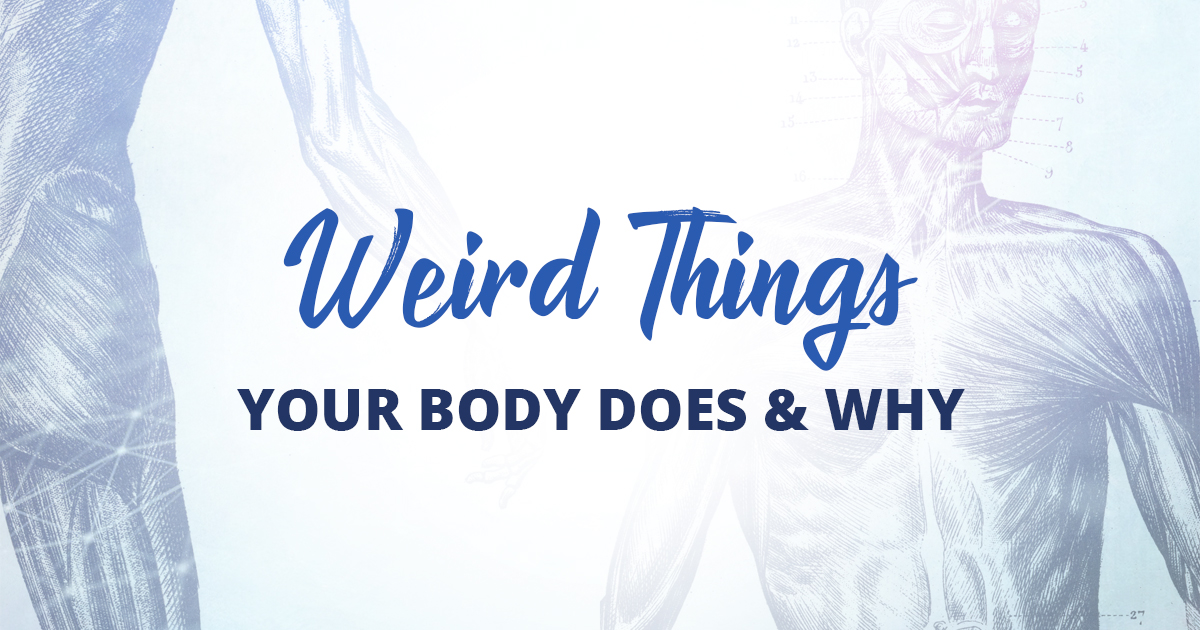Weird Things Your Body Does and Why

Let’s face it, the human body can be weird. While on the one hand, it’s an amazing, complicated collection of nerves, blood vessels, organs and bones that all communicate and work together in intricate ways, there are still many anatomical functions that are just plain strange.
That being said, let’s take a look at some of these weird bodily quirks that all of our bodies do, and find out why they happen.
Goosebumps
In scientific terms, goosebumps are known as piloerection, and they are caused by contractions in small muscles that are connected to hair follicles. This creates a depression in the skin’s surface, resulting in the hairs standing upright. The name “goosebumps” comes from the skin looking like that of a plucked bird!
It is believed that goosebumps is an inherited trait from our prehistoric ancestors, who had thicker coats of body hair, which created insulation and kept the body warm when stimulated. Our layer of body hair is too thin to make this insulation process effective, but as we know, goosebumps caused by cold, go away when our bodies warm up.
Goosebumps are also connected with various emotional situations, such as fear, nervousness or feeling moved by something. In these moments, goosebumps are triggered by the subconscious release of the testosterone hormone. During high levels of stress, either positive or negative, testosterone is released to help in the “fight-or-flight” decision-making process. This will cause goosebumps and that familiar “hair-pricking-up” sensation.
Déjà vu
We’ve all had it – that weird feeling that we’re experiencing a situation we’ve been in before. The term déjà vu is French and the literal translation means “already seen,” and there are many theories for this haunting phenomenon – past lives, dreams or even ESP.
Researchers believe that déjà vu is caused by a sort of short-circuiting between long-term memory and short-term memory. Think of your memories as divided into two inboxes: short-term and long-term. When this memory mismatch occurs, a new experience is filed in your long-term memory, completely bypassing your short-term memory box, where it’s supposed to be filed. When this happens, you have that weird sensation that you’ve been through an experience before when in reality, it’s just a glitch in your brain’s memory filing system.
There are however, a few other causes of déjà vu including epileptic seizures, sleep deprivation and being overly distracted in your daily life.
Wisdom Teeth
Wisdom teeth are just like any other molar in your mouth, in fact they are your third set of molars. Your first set grows in around age 6, the second set around age 12, and the wisdom teeth appear between the ages of 18 and 21.
Early humans were hunters and gatherers who survived on leaves, roots, meat and nuts – all foods that were tough and required a lot of grinding teeth to consume. As humans evolved, they began to cook their food and it became softer and easier to chew and through time, the third set of molars became unnecessary.
Additionally, as humans evolved, the need for super-powerful jaws decreased and human jaws became smaller and less able to support as many teeth. The number of teeth, however, stayed the same, which is why many people today need to have their wisdom teeth removed because there is no space for them.
Interestingly, because wisdom teeth aren’t necessary for modern humans, experts believe that they may someday cease to exist at all.
Sneezing
The purpose of a sneeze is fairly straightforward. Sneezes help to remove irritants from the nasal passage such as dust, dirt, pollen, smoke or any other annoyance that could get stuck up there. Blowing it all out with a good sneeze is the best way your body can clear it.
Sometimes people sneeze in pairs, or even three times. Some people have a specific number of sneezes they produce each time. If someone sneezes multiple times, every time, their sneezes may not be as powerful as a single-sneezer’s sneeze is, and it requires several attempts to get rid of the irritant.
Sneezing is also important when we’re sick in fighting bacteria. The body’s natural reaction to infection is to produce mucus in which to trap bacteria and once trapped, sneezing is best way to expel this bacteria from the body. (It’s also a good way to spread bacteria, so remember to cover your mouth and nose when you sneeze!)
Your nose is always working, producing mucus to catch potential irritants before they can get to your lungs. Sometimes, the nasal passage gets too full and you’ll get a random sneeze, even when there aren’t irritants or bacteria present. This is just your nose doing its job, resetting your nasal passage.
Not everything about sneezing is known, however, as there are still some causes that don’t make sense, even to the most astute researchers. For example, about one in four people sneeze when they look into a bright light. This is called a photic sneeze reflex and it’s actually an inherited genetic trait. The predominant theory is that a certain stimulation of the optical nerve causes the same sensation in your brain as irritation in the nose – but even this is inconclusive!
Blinking
The average person blinks about 12 times a minute, 10,000 times per day, and 4.2 million times per year.
We blink to lubricate our eyes with tears that are constantly being produced in our bodies, which are made up of three layers: the mucous layer that adheres to the eye; the aqueous layer, which is thick and hydrates the eye, keeping bacteria away; and the oily layer, which prevents the other two layers (which are predominantly water) from evaporating. Every time you blink, these tears are spread across the surface of your eye to keep it lubricated and prevent the spread of bacteria. Blinking also helps clear dust particles that are continuously getting into your eyes. When your eyes water, the extra fluid helps cleanse and soak up debris, while the blinking works like a windshield wiper, pushing it all away.
Blinking also works as a reflex in response to external stimuli, such as a bright light or a windy day at the beach. Your eyes can close in 0.1 seconds after that sand hits your eyes, and this is called the corneal reflex.
Yawning
The original theory about yawning was that it was a respiratory function and that when your body is running low on oxygen, you will yawn in order to increase the oxygen level in the bloodstream.
Researchers now believe that the primary function of yawning it to regulate temperature. Your brain is the most energy-hungry organ in your body, using about 40% of your total metabolic energy. Burning all of this energy means that your brain is hot and it needs some way to cool down. Thus, your brain uses yawning like a fan.
During a yawn, cold air is brought in through the mouth, the muscles in your jaw and around your skull contract and stretch, which also increases the blood circulation in the area. The air cools the blood, increases the heart rate and pumps cooler air to your brain. A cooler brain is a more alert brain.
There are many other triggers associated with yawning and most of them are connected to energizing your brain. For example, boredom and drowsiness mean your brain needs to be stimulated but yawning can also be triggered by anxiety, hunger or even a change of activity. Overall, try to keep in mind that when you yawn, your brain might be asking for some extra focus.
Of course, we all know that yawning is contagious (you’re probably yawning right now, just reading this!)! There are a couple of different theories about this. One is that people yawn when others yawn due to a phenomenon called echopraxia, in which a person sees a certain behavior and if they’re sensitive to it, they will mimic it. This is made possible by mirror neurons in the brain.
Some research also indicates that it is an evolved form of synchronized group behavior. Contagious yawning could be a tool for increased vigilance. Since yawning can prompt the brain to be more alert, the idea is that perhaps humans evolved to recognize someone else’s yawn as an indicator of when to trigger a more vigilant brain in themselves.
The average adult yawns an average of 20 times a day and many of these occur during shared periods of transition.
Now that you know a little more about some of the things your body does and why, they may seem a little less weird and little more fascinating!
Sources:
https:/www.interestingfacts.com/
https:/www.usatoday.com/story/life/health-wellness/2022/07/12/why-yawning-contagious/10013845002/

